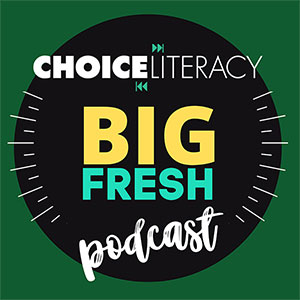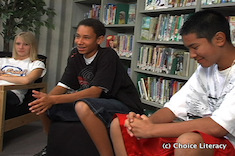Penny Kittle is a classroom teacher and literacy coach at Kennett High School in North Conway, New Hampshire. She is the author of Public Teaching: One Kid at a Time, The Greatest Catch: A Life in Teaching
(co-authored with her mentor and friend, Donald H. Graves), Write Beside Them: Risk, Voice, and Clarity in High School Writing
, and Book Love: Developing Depth, Stamina, and Passion in Adolescent Readers
. You can follow her work at http://pennykittle.net/
In this podcast, Penny chats with Franki Sibberson about adolescent reading and writing in the content areas. A full transcript is available below the player.

Franki Sibberson: Penny, can you talk a little bit about your thinking about how to help students grow as readers and writers across content areas?
Penny Kittle: Well, I’ve been lucky to be able to coach in classrooms at my high school in different content areas. And teachers are kind of perplexed with how do you help kids have the patience to kind of dig in to the difficult texts that are in content areas, as well as how do you, as a teacher, lead them through the process of writing, because a lot of my colleagues are pretty comfortable with assigning a research report, and then collecting it and assessing it. But what do you do in between? So, I had one chemistry teacher I worked with on research papers where I was able to go in and just work with the kids on the structure and organization of a lot of information, kind of in a more of a storyboard way, the way I think about organizing big ideas. And I have another class that I’ve worked with quite a bit on studying mentor texts, texts that about the same size and length of what they’re trying to write in science. And the big shift for us was to really think about the kinds of writing that kids do when they leave high school, or do in relation to what they’re understanding that will help them understand the content better. So, the shift for me is they’re experts in their content, and I know something about literacy. And the two of us, together, learn quite a bit just by working side by side.
Franki Sibberson: So it’s both teachers, together. So my next question is what can teachers do to support that writing? So you’re talking about the English literacy teacher doing some of the work and thinking, and the content teacher doing some other work?
Penny Kittle: Yes. Well, just as far as the short term coaching that I do, so that I can give them some things they can take with them. For example, I was working with content area teachers on Monday in Cape Elizabeth, Maine, and they’re such a smart school. They have the highest test scores in the state. And they still want to get better. And I love that. Really passionate teachers. But what they looked at with me were charts, tables, and graphs. And we would take them — I got several of them off the New York Times web site, which does this beautiful work with op-ed charts — and informationisbeautiful.net. And so, for example, there’s an outline of Africa filled in with all the other countries, so you can see how immense the geography of Africa is. And we just looked at it as a text. What does it say, having all those other countries kind of squished inside its boundaries? And then, how do you read it? And then, what might you say to write about it? And we did that with several different visuals, or just tables of information. And sometimes I would make a claim like use the information in this table to support my claim. And my claim is, the US should get out of Afghanistan. And then they would write sentences that would be evidence to support that claim. And what we found is that if you read, write, revise every day — which is what I believe is needed in every class — can happen in that short bit of time. They’re looking at a bunch of data and trying to make sense of it. So they’re reading it and trying to think about it with a partner. Then, they’re writing about the data to support an idea, and then revising it to make it stronger, sharing it, talking about it, how do we write from data? And it’s almost like a quick write from my classroom transformed into something that will be a building block skill that that kid can then take when they sit down and try to use evidence to support their own ideas.
Franki Sibberson: So that’s a big shift, to really do that daily kind of thinking writing in content areas, rather than just the kind of product writing. Is that — am I understanding that right?
Penny Kittle: Absolutely.
Franki Sibberson: Okay. So –
Penny Kittle: Yeah. And a lot of it — Harvey Daniels, the great book that, the one on content-area writing, with all the strategies, is a lot of what I talk about. Those are great strategies for having them process content.
Franki Sibberson: And so the big focus with nonfiction in the Common Core, and the big focus on content reading and writing, what’s your thinking on that?
Penny Kittle: Well, I think that — the 70/30 idea says that across the school day, kids should be exposed to a lot of this nonfiction reading. And I support that. I don’t think that that means that English teachers give up a big portion of literature, because we’re responsible. I don’t see my content area teachers doing a lot of literature, although I send a Iraq soldier poem to them, and things they could use. I really believe that I use nonfiction when I’m teaching research and informational writing with kids as the mentor text. We read them together. We talk about them. And so I’m doing nonfiction now, but I don’t see that I have to make a huge shift, because I need my colleagues to do more nonfiction reading. And across the school day, we all need to take this plan and make it work for everybody.
Franki Sibberson: Do you think that’s gonna be a challenge in terms of the time in the content areas? Or do you think what the work your doing is pretty seamless?
Penny Kittle: I think the challenge for all of us with the Common Core is there are just so many standards. And so, we don’t have that much time. And the idea that kids need to deeply engage with these standards. If you were to take, just for example, narrative writing, which is one of the text types that repeats grade level after grade level, well, we did our units on narrative in ninth grade this year. But not every kid reached the standard for narrative writing for grade nine. And so the big question for schools is gonna be, what do you do? Do you send those kids back to work on narratives? And if you do, how much of the rest of the standards can you possibly cover, as you do that kind of work? As you reteach and continue to work with kids on those standards, because there are many.
Franki Sibberson: And so your talk about writing, I think one of the things I’m thinking about is how we move beyond the traditional forms of that writing you do only at school. And you talked about this a little bit at the beginning. But how do you move away from just report writing, when it comes to content writing, and really looking at those — what it means to be a writer across content areas?
Penny Kittle: Yes. You know, I don’t think it’s any different then the same dilemma in English class. I think there’s way too much writing about books in English class, too much school kind of stuff that we just don’t do in the real world. And that if you’re going to ask kids to research something in science, they should be looking for an idea or a claim that they have some ownership with. There’s — when I taught research writing this fall, students spent time thinking about what they really wanted to focus their research on, and coming up with a list of questions they might want to answer in research. And you can do that in any content area. But if it’s driven by a student’s engagement, you’re gonna get so much more from the student. So, getting rid of this idea of everybody write about X and going after what are the individual questions that kids have that connect to this content area that are gonna inspire them to really dig deeply into resources and thinking, and engage with the content and the task, and produce the best work that they can.
Franki Sibberson: Okay. So when I think of the writing that kids do in high school, and the traditional stuff, it’s pretty much report writing, and it’s over and over and over the same thing. What are the other options in terms of the kinds of content writing kids could do that’s more authentic, other than school reports?
Penny Kittle: Well, they’re gonna do a lot of information explanatory text, typically like your daily kinds of assignments, to explain what they understand about the content. But there are so many forms. I’ve seen my teachers doing letters, doing digital stories, like little mini clips. My chemistry teacher, right now, in lieu of the traditional research reports, allows kids to do these videos. And I’ve posted two of them on my web site. The thinking that goes into these kids producing videos about — these are both about compounds in chemistry — is truly inspiring. And so I think you just have to think beyond the bounds. If you’re trying to get kids to show you what they understand about a piece of content, there are many options. And we need to be sure kids have the skills to write in a variety of forms. And that includes media and all the technology, and all the things that we have available to us.




